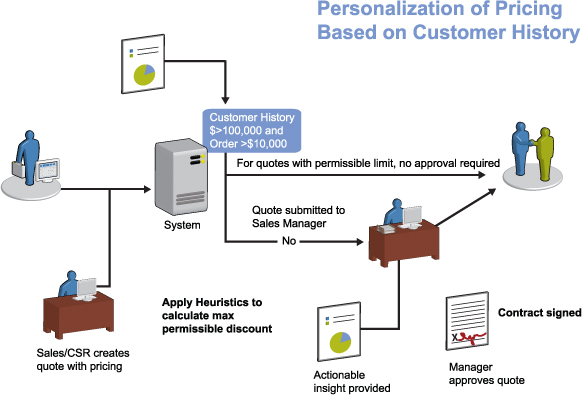
article page |
1 |
2 |
3
What are intelligent applications and how do they enable personalization?
CSPs are looking for ways to stay ahead of competitors by improving internal processes, making smarter and timelier decisions, and providing customers with a personalized buying experience. Intelligent applications can help CSPs deliver this personalized customer experience.
Intelligent applications embed business intelligence technology directly into selling, ordering, servicing, and fulfillment processes for real-time and automatic access and application of intelligence data to drive a customer-specific decision. By embedding intelligence and analytics directly in a process (for example, when determining if a business customer is applicable for a specific discount)
|
|
Intelligent applications can be looked at as “on” a process, “in” a process, or “driving” a process. |
|

key performance indicators (KPIs), and making a recommendation to the user on the best way to proceed. Front-line employees can be empowered to make consistently better decisions by providing them with relevant metrics available to them at the appropriate time.
For example, with intelligent applications, as a field sales person enters a quote for a particular item, they would see a pop-up window for that line item that provides them with insight into previously successful quote discount percentages for that product
|
|
|
|
|

CSPs can enhance process flows and system and user decision making by accessing, interpreting, and applying the last customer and business intelligence to drive how a decision is made or how a process executes.
Intelligent applications can be looked at as “on” a process, “in” a process, or “driving” a process where specific customer decisions need to be made, such as personalizing an offer or fulfillment plan. Intelligence on a process is analogous to looking in the rear view mirror, and allows CSPs to view and identify trends through data marts and key metric dashboards, and to correct any problems. For example, a sales manager can view reports that show sales performance by revenue, number of closed deals, and sales by individual team member.
Intelligence in a process, like looking forward through the front windshield, improves decision making at critical points in customers’ processes by analyzing customer history or
|
|

category or industry or customer. This would help them make a recommendation. With this information, the field sales person can provide the appropriate quote discount percentage that will hopefully be accepted by a customer.
And, most impactful, is intelligence driving the process uses events in selling and fulfillment process to automatically trigger decisions, or even to modify the process flow itself. For instance, intelligent applications support driving the offer qualification and presentation process by automatically determining the best offer to present to the customer. This includes selecting promotions and terms, based on the customer’s profile including billing and payment history and customer longevity. This can be done when a user (either in the call center, retail site, or on the web) browses for available offers. Many other scenarios improve decision-making at critical points in the business process.
|
|




